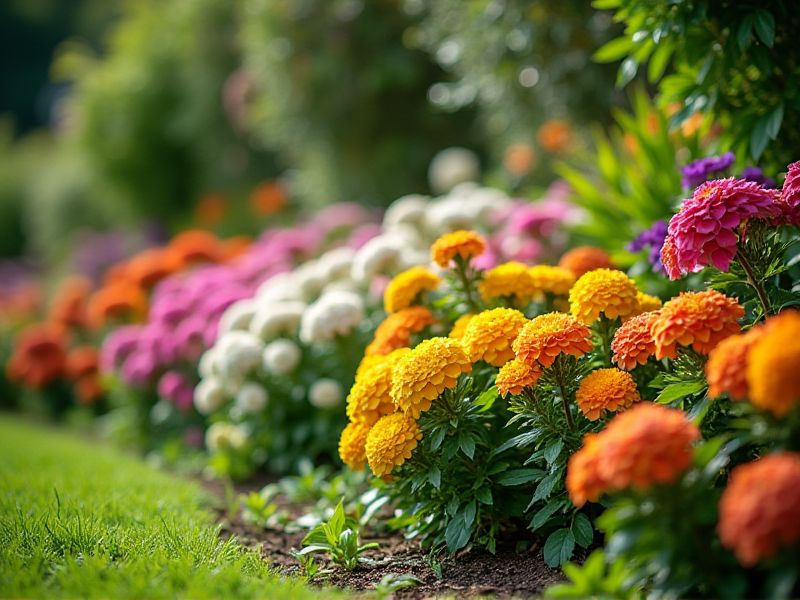
Brightly colored plants can transform shaded areas into vibrant sanctuaries. Consider options like Hostas, which display stunning variegated foliage and thrive in low-light conditions. Astilbes offer feathery plumes of pink, red, or white, adding texture and color to your garden. Japanese forest grass, with its golden hues, provides a striking contrast against darker backdrops. Incorporating these plants not only enhances aesthetic appeal but also promotes a lively ecosystem in shaded environments.
List of some Colorful plants that brighten shade areas
- Astilbe (Astilbe)
- Bleeding Heart (Lamprocapnos spectabilis)
- Japanese Painted Fern (Athyrium niponicum)
- Heuchera (Heuchera)
- Hosta (Hosta)
- Coral Bells (Heuchera sanguinea)
- Toad Lily (Tricyrtis hirta)
- Lungwort (Pulmonaria)
- Leopard Plant (Ligularia)
- Foamflower (Tiarella)
Important things about Colorful plants that brighten shade areas
Foliage Variety
Colorful plants are ideal for brightening shaded areas in your garden, with varieties such as hostas, astilbes, and ferns transforming dim spaces into vibrant oases. Hostas, known for their lush foliage and diverse color palette ranging from deep greens to striking blues and yellows, thrive in low-light conditions while adding texture. Astilbes, with their feathery plumes in shades of pink, white, and red, bring a touch of elegance and flourish during midsummer, exceptionally contrasting against the green backdrop. Incorporating these colorful plants not only enhances the aesthetic appeal of your shaded garden but also supports local biodiversity by attracting pollinators.
Flowering Options
Colorful plants such as astilbe, hostas, and caladiums thrive in shady areas, bringing vibrant hues to dim corners of your garden. The astilbe, with its feathery plumes in shades of pink, red, and white, adds a dramatic touch while attracting pollinators. Hostas, known for their lush foliage, offer a stunning variety of leaf colors and patterns, enhancing visual interest even during bloomless seasons. Incorporating these plants into your landscape ensures that your shaded spaces are not only filled with color but also vibrant with life and texture.
Leaf Patterns
Colorful plants, such as Coleus and Heuchera, offer stunning leaf patterns that can enliven shaded areas in your garden. These plants display vibrant hues and intricate designs, transforming dreary corners into eye-catching spots. The variegated foliage of the Rex Begonia, with its marbled and speckled leaves, provides a striking contrast against the verdant backdrop. By choosing these unique plants, you create a dynamic landscape that thrives in low light while showcasing nature's artistry through captivating leaf patterns.
Seasonal Changes
Colorful plants like heucheras, astilbes, and ferns can transform shaded areas into vibrant gardens throughout the seasons. Heucheras, with their stunning leaf colors ranging from deep purple to bright lime green, provide year-round interest even in low-light conditions. Astilbes, offering fluffy plumes in shades of pink and white, thrive in moist, shady spots and bloom in midsummer, adding striking visual appeal. Incorporating these plants into your landscape design not only enhances aesthetic value but also supports local wildlife, creating a thriving ecosystem in shaded environments.
Native Species
Colorful native plants such as Coral Bells (Heuchera spp.) and Japanese Painted Fern (Athyrium niponicum) can bring vibrant hues to shaded garden spaces. The bright foliage of Heuchera varieties ranges from deep burgundy to lime green, making them excellent focal points in low-light environments. Meanwhile, the striking coloration of the Japanese Painted Fern showcases silvery-green fronds with burgundy veins, enhancing the overall aesthetic of your garden. Incorporating these native plants not only adds visual interest but also supports local ecosystems by providing habitat for pollinators and wildlife.
Growth Habits
Colorful plants that thrive in shade areas can significantly enhance your garden's aesthetic appeal. Consider incorporating varieties such as Astilbe, with its feathery plumes in shades of pink and white, or Hostas, which offer vibrant green and variegated leaves that create a lush backdrop. Caladiums bring a burst of color with their striking heart-shaped leaves, available in red, pink, or white, perfect for adding visual interest to dimly lit spots. By choosing the right combinations of these shade-loving plants, you can transform your outdoor space into a vibrant sanctuary, even in the absence of direct sunlight.
Soil Requirements
Colorful plants that thrive in shaded areas often require well-draining, nutrient-rich soil to flourish. Adding organic matter like compost can enhance soil fertility, ensuring that plants receive adequate moisture and nutrients. Most shade-loving plants prefer slightly acidic to neutral pH levels, typically ranging from 5.5 to 7.0, which promotes optimal growth. Consider selecting species such as Astilbe or Heuchera, as they not only tolerate lower light conditions but also bring vibrant colors to your garden.
Watering Needs
Colorful plants that thrive in shaded areas often have unique watering requirements tailored to their environment. For instance, varieties like the Heuchera and Astilbe prefer consistently moist soil, while others like ferns may require less frequent watering, depending on the humidity. When planning your garden, consider using mulch to help retain soil moisture for these vibrant plants, promoting healthy growth and color vibrancy. Regularly monitoring the soil's moisture level is crucial, ensuring that these shade-loving plants receive the right amount of hydration without the risk of oversaturation.
Companion Planting
Colorful plants such as Begonias and Coleus thrive in shaded areas while providing vibrant pops of color to otherwise dull spaces. These shade-loving perennials not only enhance the aesthetic of your garden but also attract beneficial pollinators like bees and butterflies. Incorporating plants like Astilbe and Heuchera can further enrich your garden with their striking foliage and floral displays. By selecting these varieties, you can create a stunning and lively shade garden that elevates the overall beauty of your outdoor space.
Maintenance Levels
Colorful plants such as hostas, caladiums, and coleus thrive in shaded areas and add vibrant hues to gardens. These plants require minimal maintenance, making them ideal for homeowners seeking low-effort landscaping solutions. Providing adequate moisture and well-drained soil will ensure your shade garden remains healthy and lush. By incorporating perennials like ferns or astilbes alongside these colorful species, you can create a diverse and visually appealing environment even in darker corners of your yard.
